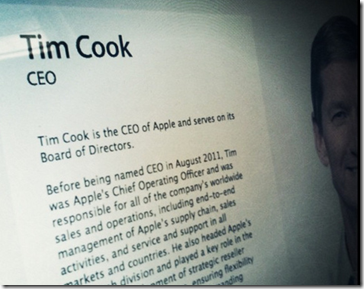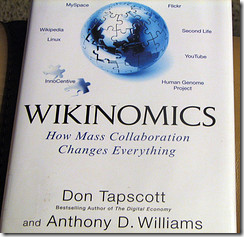 Why not deliver on a vision for an Economic Social Nervous System on a foundation of mass collaboration? Today I read on Business Insider, the story by Kevin Smith and Owen Thomas “ATTENTION TIM COOK: Here’s Apple’s Startup Shopping List.” You should read it for your own context.
Why not deliver on a vision for an Economic Social Nervous System on a foundation of mass collaboration? Today I read on Business Insider, the story by Kevin Smith and Owen Thomas “ATTENTION TIM COOK: Here’s Apple’s Startup Shopping List.” You should read it for your own context.
The premise I took from the authors is that Tim Cook, CEO of Apple, has reorganized Apple’s top management. And now with Apple’s cash (even with the slip in the market) it’s time for Tim Cook to go on a shopping spree and acquire some companies.
I’m a Chief Marketing Officer or “CMO,” a strategy and operations type with skills developed through experience in both product and services companies, in roles from board member, director to advisor, which makes my mind wander a little farther off the beaten path.
Seems like the suggestion in the article could be a logical short-term, finance-driven directive. However, I saw a different opportunity for a more creative and visionary directive. One that could rewrite the legacy of Apple, and be the cornerstone of Tim Cook’s leadership. Tim is sharp and perhaps this is one he is considering already, or will consider shortly. [I’m available to help, Tim!]
Converging Mass Collaboration With Apple Creativity
 I just finished reading the classic book (and blog), Wikinomics, by Don Tapscott and Anthony D. Williams, and while it’s a great book, it was perhaps a few years ahead of its time. The pressures of the economic collapse of 2008 and the recent resurgence of the global entrepreneurial community have made its message more poignant than ever. [Time to write the follow on book, Don and Anthony!]
I just finished reading the classic book (and blog), Wikinomics, by Don Tapscott and Anthony D. Williams, and while it’s a great book, it was perhaps a few years ahead of its time. The pressures of the economic collapse of 2008 and the recent resurgence of the global entrepreneurial community have made its message more poignant than ever. [Time to write the follow on book, Don and Anthony!]
Why is this book’s message important? How does it tie in with the Story on Apple in Business Insider? Well, the assumption of the Business Insider article as I read it is that Tim Cook is going to keep Apple’s culture the same. That is to say, own and control everything Apple. That is to further say, control the apps that can innovate, exist and sell into the Apple ecosystem.
Gosh, I hope not. I posted this comment online, to that story:
Not sure I would draw the same conclusion. Perhaps (reading between the lines) this is Apple’s opportunity to break free, and ignite mass collaboration and new innovation of the kind Don Tapscott and Anthony D. Williams wrote of in Wikinomics. Apple has not nurtured “ideagoras” nor built “platforms for participation” of the type that Linux has proven can work, and which has delivered quantum results (e.g., Apache). Why buy these 10 companies, when leveraging ideagoras and nurturing platforms can do so much more. 10 years ago, the closed controlled approach brought structure to chaos. With Social Democratization, chaos self-organizes. Certainly Google, and potentially Microsoft, see Apple’s Achilles heel. Apple cannot control the community they created, forever, any more than a parent can assume that the child stay home forever under his/her influence. Eventually, the DNA inside will take over. It can be a destructive cancer, or a Darwinian shot in the arm.
Andrew Stein
SteinVox
Wikinomics Tells Us Why
Ideagoras provide marketplaces for ideas, innovation and uniquely qualified minds. This is crowdsourcing. Prosumers are the proverbial early adopters that hack products to do new things their inventors never thought of – creating innovative new ideas to feed the ideagoras. The New Alexandrians fundamentally share for the benefit of science and others who can leverage learning, resulting in greater good for many, and often, all (everyone). The proof of Linux and real Platforms for Participation is a stage that Apple must learn to share with others. The Global plant Floor is being driven by the demands of a BYOD (bring your own device) society, and there is more than one device to bring. Connecting these requires more openness.
The concepts in bold text above are entire chapters from the book. I can’t do them justice in my blog – but they are undeniable.
We’re All In This Together
While we were not looking, and since the book came out…, and while Apple has been evolving – post Steve Jobs. Social environments (not just social media) have evolved into the global economic social nervous system of the network. The network is how we really see the world today, not just a set of continents divided into countries with differences – but a connected group of people with many things in common, most importantly the ability to communicate.
Connected machines and people are creating an organic system that is driving the future. Intelligent analytics, of the prescriptive analytics type processing real-time rolling distribution curves, are evolving to replace historical-based predictive analytics that usually are too late to the decision table to be of real use. I first read about this economic social nervous system in 2009. Joshua-Michelle Ross wrote, “The Rise of the Social Nervous System” in Forbes, back in March of that year.
We see this change coming every day now. For example, with GE’s concept of the Industrial Internet or the change being driven on Tahrir Square in Egypt, and other places where the voice of people is being heard over the voice of oppression in order to bring about a new balance of mass collaboration and leadership (both industry and government).
An Economic Social Nervous System
A network of socially connected people on a global scale is the ultimate in mass collaboration that the authors of Wikinomics touched on in terms of industry. The opportunity for Tim Cook to take Apple into a radical and profound direction built on the foundation that the book has laid is there. It’s an opportunity to step-up and be something more than Google’s “Do No Harm” vision, which is showing its age as Google builds driverless cars, redesigns all Search, Chrome and other platforms and otherwise finds its way. Who knows what vision Microsoft might come up with? But, if Apple waits too long to take this opportunity, we will find out.
It’s a perfect time for Tim Cook to set a course for a new Apple Vision that reflected the power and potential of this new economic social nervous system. However, this window of opportunity is sure to evolve and is not guaranteed to belong to Apple. Steve Jobs had “design DNA.” Does Tim Cook have Servant Leadership DNA? Time will tell.
This is a once in a lifetime opportunity to build an even bigger corporate legacy for the CEO of a highly influential company on so many fronts. This opportunity to give back to the social nervous system it owes thanks to for its monumental success. So few companies achieve this level of success and the opportunity to shift vision to give back. This opportunity allows Apple to give back, AND continue to design their own new future in the resulting new economic social nervous system.
Please comment. Other readers would love to hear your thoughts on this subject.
Image credits: Tim Cook photo: spieri_sf via photopin cc
Bio screen shot: falfi.strife via photopin cc
Wikinomics book: colemama via photopin cc










I really have no idea what direction Apple is going. Disappointed that they have been holding up the progress of NFC in our country. Shocked to learn one of their early brand advocates ditched them: http://read.bi/TP8YLg
“Success is a lousy teacher. It seduces smart people into thinking they can’t lose.” Bill Gates